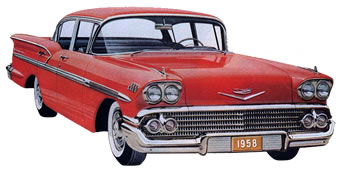 The 1958 Impala Bel Air was the right car at the right time. The top-of-the-line, it featured new front end and rear end styling and was longer, lower and wider than its predecessors. Just looking at sales material from the period shows you the radical change the 1958 brought.
The 1958 Impala Bel Air was the right car at the right time. The top-of-the-line, it featured new front end and rear end styling and was longer, lower and wider than its predecessors. Just looking at sales material from the period shows you the radical change the 1958 brought.
The front end was wider than its predecessor. It was inches lower than the 1957 and the big fins had turned into more styled rear ends where the Bel Air featured three rear light s and the standard Impala two. It seems as if they took the huge fin of the 57 and bent it down and around into a flat styling piece. It defined the reared as it looked like a semi-oval with three (or two) lights centered.
Chevrolet started releasing teasers as early as the Motorama show of 1956 where some of the styling cues that were later to show up were revealed such as the heavy used of chrome in in the front end and the long hood.
Chevy’s design team and Pontiac’s worked closely together Pontiac’s on the early models. This led to one corporate decision that would be made – Chevy would use the shared “A” corporate body. This body restyle was fun for the design team. The front end became far more rounded with a lower grille and the rear became sculpted.
There was also going to be a new chassis underneath as the perimeter frame was abandoned in favor of what Chevy designers termed a modified X-frame. The design team – heading toward unibody construction, although they didn’t know it at the time – decided to criss-cross the frame members as they abandoned the typical ladder-on-frame production (the vehicle chassis was designed around a square with “ladder rungs” across from side to for rigidity). The Chevy design team, with a good deal of data to back them up, noted that by using an X configuration not only could you relocate the wheels, but you also were enhancing the inherent rigidity of the frame because the X could absorb torsional stress than the standard ladder/frame chassis.
The interesting piece for this was the X configuration also meant that you could lower things substantially and increase the amount of interior space, as well as the height of the vehicle.
As noted, this was a landmark vehicle. The design team opted for coil springs over leaf springs. Coils were also used up front and Chevy innovated with special points, it called links that pivoted and helped keep wheels flat on the road. Overall, the suspension changes – lower trailing arms retained up front and the results was a good, but soft ride.
There were new engine choices, although the 283 was still retained as the standard on the Impala, although the horsepower was beefed up to 265. Other engine changes included a compact 348 (350) cubic-inch engine whose configuration could by changed from 250 horsepower to 380, depending on the carburetion. Other standard engine choices included a 145-horsepower sixes and the 283 short-block.
The top-of-the-line Bel Air, that offered the 380, was available as a convertible or a coupe. The following year the Impala got promoted from a sub-series of the Bel Air became a series in its own right.
